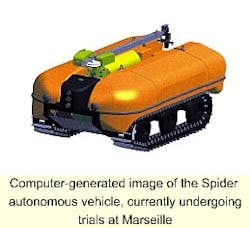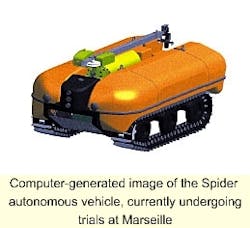Autonomous vehicle cuts cost of pipeline installation review
Monitoring of the touchdown point during offshore pipelay has become standard procedure. The main aims are to check the portion of the pipe on the seabed, (to see whether it matches its theoretical corridor), to detect unex pected obstacles during laying and to verify inte grity of the pipe, in case it needs to be recovered.
Traditionally, these tasks have been conducted by an ROV (remotely operated vehicle) supported by a dedicated support vessel sailing at the laybarge's stern, unless the distance to the touchdown point (TDP) is so short that the ROV can be supported entirely from the barge itself. Where a support vessel is required, this can consume up to 90% of the monitoring cost, especially in deepwater, where a dynamically positioned vessel would be needed.
Cybernetix, a specialist in advanced subsea robotics, has developed an alternative solution in association with Stolt Offshore and Orca, based on an autonomous vehicle that can perform this monitoring exercise without the need for a dedicated vessel, and regardless of water depth or distance to the TDP. The vehicle, named Spider, is a fully electrical underwater crawler with numerous special features including a 50 kWhr battery pack, allowing up to 15 km of pipe to be inspected, even in harsh conditions.
The overall system is delivered to the laybarge in a 20 ft container housing two back-to-back vehicles. The vehicles' low weight (each 3.5 tons) allows them to be launched directly from this container using a small winch and a hydraulically deployed A-frame. Once the Spider has reached the seabed, the lowering cable is released and then directed by the operator to the area of the TDP, using a graphical navigation interface.
The Spider's monitoring tool comprises a telescopic pole mounted on a pan and tilt tower. A pan and tilt camera standing at its extremity is positioned between 10 cm and 1 meter above the pipe. This camera gives a full view of the area around the pipe, thereby avoiding the need for the vehicle to cross over it.
The control system, split into a surface and bottom unit, is designed for semi-automatic pipe monitoring, and includes two of a new generation of acoustic beacons. These provide:
- Reliable, bi-directional low speed acoustic link for commands and the data exchanged between the control station and the vehicle
- High-speed link for the video transmission, at a comfortable image refreshing rate, via four sources that include the bottom monitoring unit.
Once video contact with the pipe has been established, the vehicle's tracks and monitoring tool can both be controlled by the embedded command system, which uses as a pipe tracker the video camera coupled to a video treatment system that offers numerous servo modes as two axes scrolling or as automatic pipe following. The tracks have been designed for an optimal compromise between motricity and ground pressure (the vehicle is compatible with ground pressure as low as 3 kPa). They are powered by electric motors to provide 500 daN tractive force. The vehicle has a nominal speed of 6 meters/min with a potential maximum speed of 20 meters/min.
Free spans are measured using an acoustic profiler with a range of up to 50 meters. A dedicated or on-site acoustic base, coupled with a DGPS (differential global positioning system), provides the vehicle's absolute coordinates and hence the pipe's absolute position.
The vehicle's high power density lead acid battery pack provides autonomous operation for more than 48 hr, or 15 km at a nominal speed of 0.1 meter/sec. Cybernetix's sister company Comex has experience with such packs on its autonomous two-seater mini-submarine, the Remora 2000. When the Spider's batteries are running low, it can be replaced by the second vehicle. This ensures continuity of the mission, whatever the duration.
The "decommissioned" vehicle returns to the surface using its automatic 600 liter ballast system. The same procedure can be applied in an emergency, forcing the battery power pack to be discharged. According to Cybernetix, the ballast system operates even in severe pitch and roll conditions, and also functions if the vehicle has been flipped over.
A prototype Spider has been constructed and is currently undergoing trials in a 500-meter-long test basin at the harbor in Marseille, in front of Cybernetix's new workshop. The main aim is to validate the concept for operations in water depths of 500 meters. However, the eventually industrialized version will be targeted at 1,500-meter depth operations.
The Marseille trials comprise firstly functional tests, to confirm that all subsystems work underwater, followed by endurance trials for the battery power pack, and concluding with a test installation of a small piece of pipe. However, the harbor-front basin is not deep enough to provide accurate feedback on the acoustic communications package. This will be tested separately in 500 meters of water off Toulon later in the year.
Cybernetix is also seeking European Union backing for a "Pyrolift" system. This would involve application of a gas generator that could generate large volumes at intense pressure - around 200 bar - which would provide sufficient buoyancy to raise an industrialized version of the Spider from an ultra-deepwater inspection operation.

